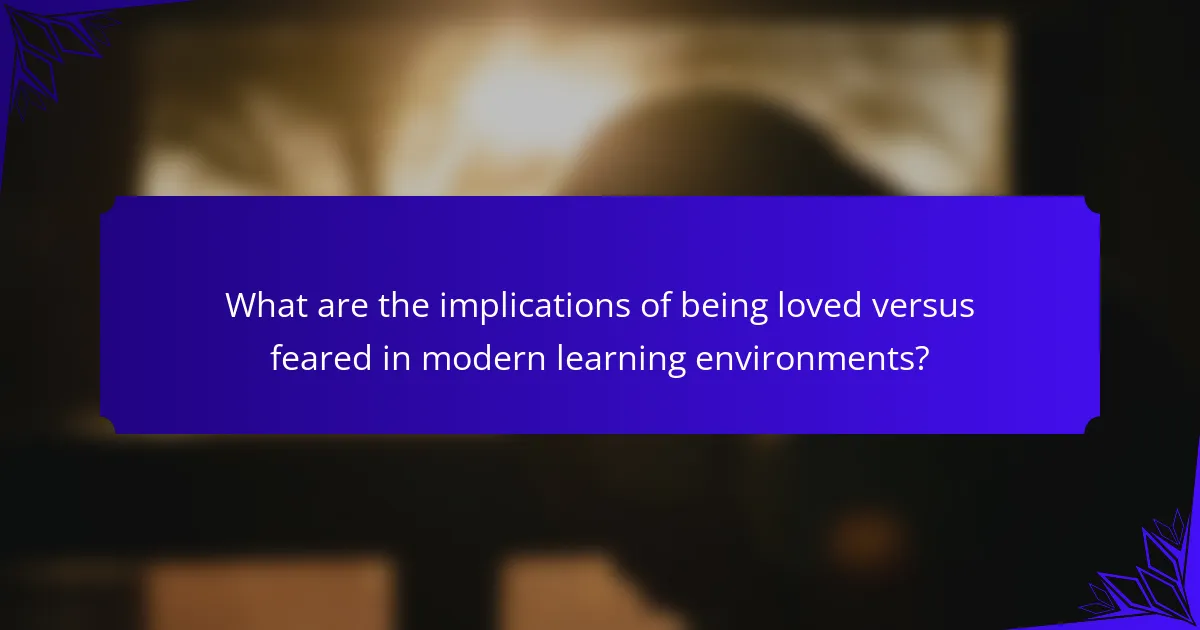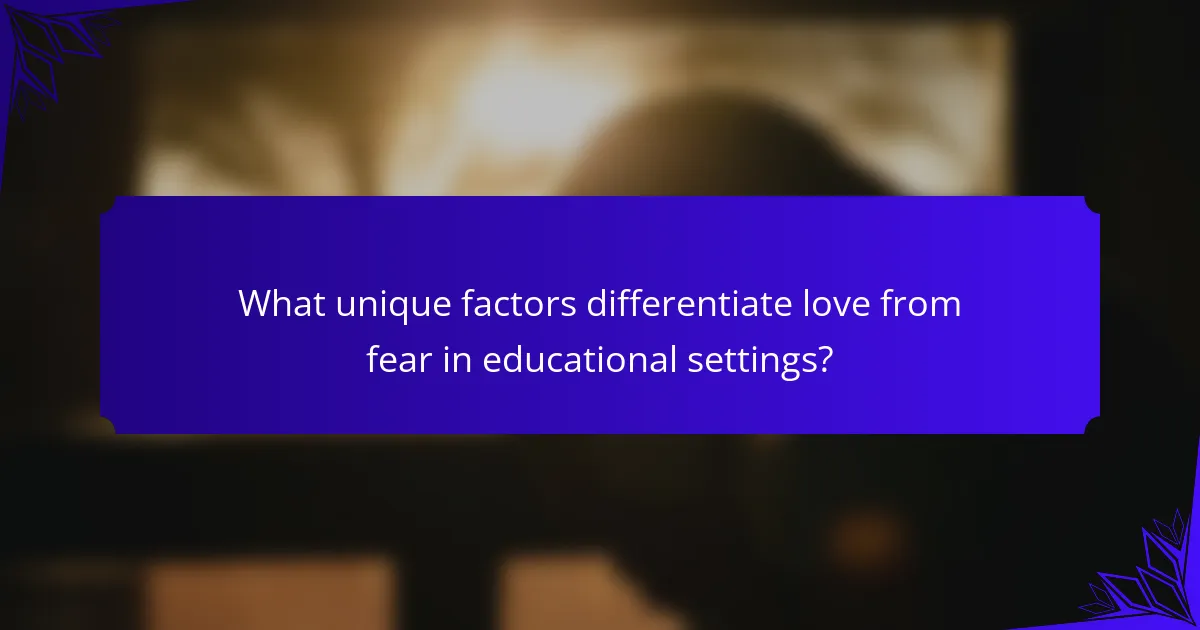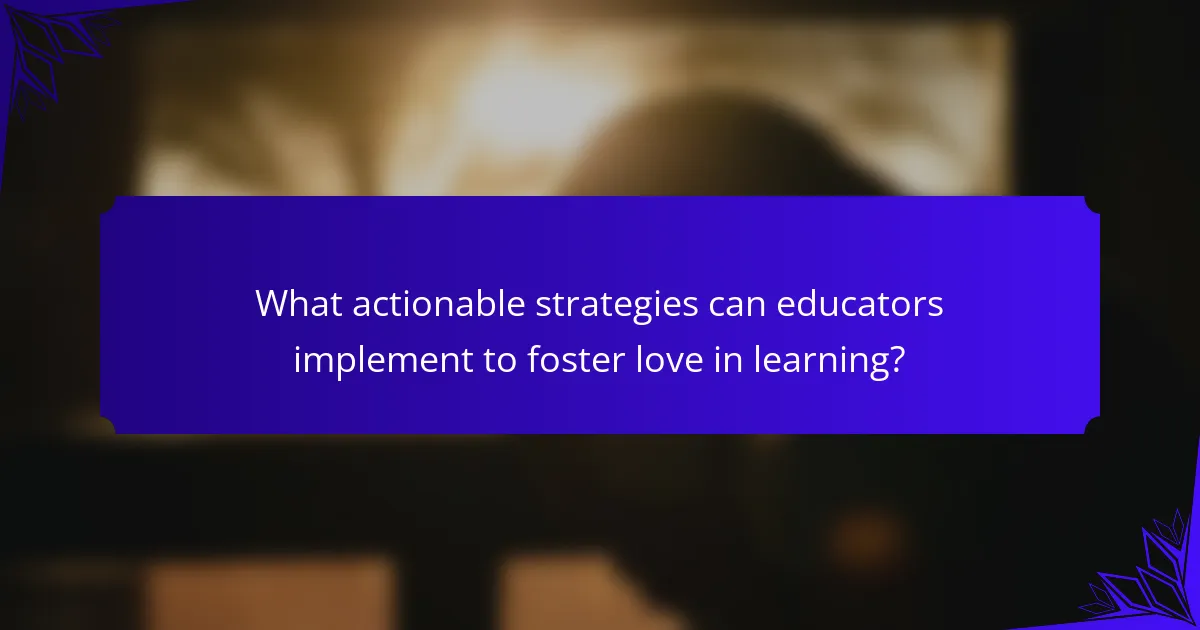In modern learning environments, the debate between being loved or feared is crucial for student success. Love fosters open communication and collaboration, while fear can lead to compliance but stifles creativity. Effective learning prioritises emotional support, adaptability, and technology integration to enhance engagement. Balancing these approaches, along with emotional intelligence and cultural sensitivity, creates a positive atmosphere for learning.

What are the implications of being loved versus feared in modern learning environments?
Being loved fosters a supportive learning environment, while being feared can create a culture of compliance. In modern learning environments, being loved encourages open communication, collaboration, and student engagement. Research shows that students perform better when they feel emotionally supported. Conversely, being feared may lead to short-term compliance but can stifle creativity and critical thinking. A balance is essential; educators should aim to be respected rather than feared, promoting a culture of trust. Ultimately, love in education enhances motivation and fosters a positive atmosphere conducive to learning.
How do emotional connections influence student engagement?
Emotional connections significantly enhance student engagement by fostering a supportive learning environment. When students feel valued and understood, their motivation and participation increase. Research indicates that emotionally connected students are more likely to exhibit persistence, creativity, and collaboration. This connection serves as a unique attribute that differentiates effective learning environments from traditional, fear-based approaches. Engaging students emotionally leads to improved academic performance and deeper learning experiences.
What role does authority play in classroom dynamics?
Authority plays a crucial role in classroom dynamics, influencing student engagement and behaviour. A balance between being loved and feared can foster a positive learning environment. Research indicates that authoritative teaching styles, which combine respect and support, lead to better academic outcomes. Teachers who establish clear expectations and maintain discipline while showing empathy create a safe space for learning. This dual approach encourages student participation and respect, enhancing overall classroom effectiveness.
How does fear affect student behaviour and performance?
Fear negatively impacts student behaviour and performance by inducing anxiety and reducing motivation. Students experiencing fear may avoid participation, leading to lower engagement and hindered learning outcomes. Research indicates that a supportive environment fosters better academic results, while fear-based approaches can result in detrimental effects on self-esteem and academic achievement. Encouraging a balance of respect and support is essential for optimal student development.
What are the benefits of a nurturing teaching approach?
A nurturing teaching approach fosters emotional safety and enhances student engagement. This method promotes a positive learning environment, leading to better academic performance and social skills. Students feel valued, which encourages participation and collaboration. Research indicates that nurturing environments can reduce behavioural issues and improve overall well-being.

What universal attributes define effective learning environments?
Effective learning environments prioritise engagement, support, and adaptability. Key attributes include a positive atmosphere, accessibility, and varied instructional methods. These elements foster motivation and accommodate diverse learning styles, enhancing overall effectiveness. A unique attribute is the integration of technology, which facilitates personalised learning experiences. As a result, modern environments that balance love and structure yield the best outcomes for learners.
How do respect and trust impact teacher-student relationships?
Respect and trust significantly enhance teacher-student relationships by fostering a supportive learning environment. When students feel respected, they are more likely to engage actively and express themselves. Trust encourages open communication, allowing students to seek help without fear of judgement. Research indicates that positive relationships lead to improved academic performance and increased motivation. In modern learning environments, prioritising respect and trust over fear cultivates a collaborative atmosphere that benefits both teachers and students.
What are the key characteristics of a positive learning atmosphere?
A positive learning atmosphere is characterised by respect, support, and engagement. Respect fosters open communication, allowing students to express themselves without fear. Support from educators and peers enhances confidence and motivation. Engagement through interactive and relevant activities promotes deeper understanding and retention of knowledge.

What unique factors differentiate love from fear in educational settings?
Love fosters collaboration and trust, while fear creates compliance through anxiety. In educational settings, love encourages open communication and a positive learning environment, enhancing student engagement. Conversely, fear may lead to short-term results but can stifle creativity and critical thinking. Research shows that emotionally safe environments promote better academic outcomes, highlighting love’s unique advantage over fear in modern learning.
How do cultural perspectives shape perceptions of authority?
Cultural perspectives significantly influence how authority is perceived in modern learning environments. In cultures that prioritise collectivism, authority may be viewed as a communal responsibility, fostering collaboration and respect. Conversely, in individualistic cultures, authority often emphasises personal achievement and autonomy, which can lead to a more competitive atmosphere.
Research shows that students from collectivist backgrounds may respond better to being loved by authority figures, valuing emotional connections and support. In contrast, those from individualistic cultures might prefer a feared approach, associating authority with competence and decisiveness.
Ultimately, the effectiveness of being loved or feared hinges on the cultural context. Educators must adapt their authority styles to align with students’ cultural backgrounds to enhance engagement and learning outcomes.
What specific teaching styles promote love over fear?
Teaching styles that promote love over fear focus on fostering positive relationships and emotional safety. Approaches like constructivist teaching encourage collaboration and student agency, creating a supportive environment. Additionally, trauma-informed practices prioritise understanding students’ emotional needs, fostering trust. These methods enhance engagement and motivation, leading to better learning outcomes.
How does emotional intelligence contribute to effective teaching?
Emotional intelligence is crucial for effective teaching as it fosters strong relationships and enhances student engagement. Teachers with high emotional intelligence can recognise and manage their emotions, as well as empathise with students, creating a supportive learning environment. This approach leads to increased motivation and improved academic performance. Research indicates that emotionally intelligent teachers positively influence classroom dynamics, promoting collaboration and reducing behavioural issues. Ultimately, emotional intelligence equips educators to adapt their teaching strategies to meet diverse student needs, enhancing overall educational outcomes.
What are the long-term effects of a fear-based learning approach?
A fear-based learning approach can lead to long-term negative effects such as reduced motivation, increased anxiety, and hindered creativity. Students may develop a fear of failure, which can stifle their willingness to take risks in learning. Research indicates that environments fostering fear can diminish critical thinking skills and discourage collaboration. As a result, the overall learning experience becomes less effective, impacting both academic performance and personal development.

What rare attributes can influence the balance between love and fear?
Balancing love and fear in modern learning environments can be influenced by rare attributes such as emotional intelligence and cultural sensitivity. Emotional intelligence allows educators to connect deeply with students, fostering trust and reducing fear. Cultural sensitivity enhances understanding and respect, creating a more inclusive atmosphere. These attributes can lead to a more harmonious balance, promoting engagement and motivation in learners.
How do specific educational philosophies address this balance?
Educational philosophies balance love and fear in modern learning environments by emphasising relationships, authority, and motivation. Constructivism promotes love through supportive teacher-student interactions, fostering a positive atmosphere. In contrast, behaviourism may lean towards fear by using external rewards and punishments to shape behaviour. The challenge lies in integrating these approaches to create an environment that encourages engagement while maintaining respect and discipline. A blended approach can enhance student motivation, leading to better learning outcomes.
What case studies highlight successful love-based teaching strategies?
Love-based teaching strategies have shown success in various case studies, emphasising the importance of emotional connections in education. One notable example is the work of Dr. Rita Pierson, who highlighted the impact of building relationships with students. Her TED Talk illustrates how fostering a loving environment enhances student engagement and achievement. Another case study involves the Responsive Classroom approach, which integrates social-emotional learning with academic instruction. Schools implementing this strategy report improved student behaviour and academic performance, demonstrating the effectiveness of love-based teaching. Additionally, research from the University of California indicates that teachers who express care and support lead to higher student motivation and lower dropout rates. These cases collectively underscore that love in education fosters a more effective learning environment.
What unexpected outcomes arise from prioritising fear in education?
Prioritising fear in education can lead to decreased student engagement and creativity. Students may become anxious, resulting in lower academic performance. Fear-based environments can stifle collaboration, as students may avoid sharing ideas due to fear of criticism. Additionally, such an approach can foster resentment towards authority figures, undermining trust in educators. Long-term, this can create a cycle of fear that hinders personal and academic growth, ultimately affecting the overall learning experience.
How can educators cultivate a loving environment in challenging contexts?
Educators can cultivate a loving environment by prioritising empathy and understanding in their interactions. Building trust through consistent support and positive reinforcement fosters a sense of safety. Incorporating collaborative activities encourages connection among students. Regular feedback can enhance communication and strengthen relationships, creating a nurturing atmosphere even in challenging contexts.

What actionable strategies can educators implement to foster love in learning?
Fostering love in learning requires actionable strategies that prioritise emotional connections. Educators can implement personalised feedback, create inclusive environments, and encourage collaborative projects. These approaches build trust and engagement, enhancing student motivation and retention. For instance, incorporating student interests into lessons can significantly boost enthusiasm for learning. Additionally, regular check-ins on student well-being promote a supportive atmosphere, reinforcing the notion that love in learning cultivates a positive educational experience.
What best practices enhance emotional connections in the classroom?
Building emotional connections in the classroom enhances student engagement and learning outcomes. Best practices include fostering a supportive environment, encouraging open communication, and showing genuine interest in students’ lives.
Creating a safe space allows students to express themselves without fear of judgement. Regularly checking in with students about their thoughts and feelings strengthens relationships. Incorporating personal anecdotes can also humanise educators, making them more relatable.
Utilising collaborative activities promotes teamwork and empathy among students. This approach not only builds connections but also enhances social skills. Recognising and celebrating individual achievements fosters a sense of belonging and boosts self-esteem.
Lastly, integrating emotional intelligence training into the curriculum equips students with skills to manage their emotions and understand others, further solidifying emotional bonds within the classroom.
What common mistakes should be avoided when trying to balance love and fear?
To balance love and fear effectively, avoid being overly authoritative, neglecting empathy, or failing to communicate openly. Striking a balance between these elements fosters a positive learning environment. Additionally, ignoring individual needs can lead to disengagement. Recognising the unique attributes of each learner enhances connection and motivation.
How can feedback be used to build trust and respect?
Feedback fosters trust and respect by promoting open communication and accountability. When learners receive constructive feedback, they feel valued and understood. This process encourages a supportive environment where individuals are more likely to engage and collaborate. Furthermore, consistent feedback helps establish clear expectations, reducing uncertainty and building mutual respect among peers and educators. Trust grows as individuals recognise that feedback is aimed at personal and collective improvement, rather than criticism. Ultimately, effective feedback mechanisms contribute significantly to a positive learning culture.
What expert insights can guide modern educators in this dilemma?
To navigate the dilemma of being loved or feared, modern educators should prioritise fostering a supportive environment. Research indicates that students thrive in settings where they feel valued and respected. Building strong relationships enhances engagement and motivation. Emphasising empathy and understanding can lead to better academic outcomes. Encouraging collaboration over competition cultivates a positive classroom culture. Ultimately, being loved promotes a conducive learning atmosphere.


